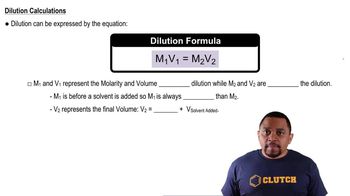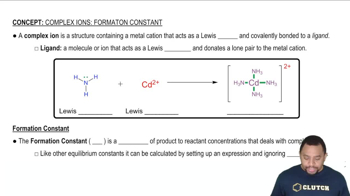Here are the essential concepts you must grasp in order to answer the question correctly.
Molarity and Dilution
Molarity (M) is a measure of concentration defined as the number of moles of solute per liter of solution. When two solutions are mixed, the total volume changes, affecting the concentration of each solute. To find the new concentration after mixing, one must calculate the total moles of solute and divide by the total volume of the mixed solution.
Recommended video:
Equilibrium and Le Chatelier's Principle
Chemical equilibrium occurs when the rates of the forward and reverse reactions are equal, resulting in constant concentrations of reactants and products. Le Chatelier's Principle states that if a system at equilibrium is disturbed, it will shift in a direction that counteracts the disturbance. This principle is crucial for predicting how the concentrations of Ag+ and other species will change when NaCN is added.
Recommended video:
Complex Ion Formation
In this scenario, Ag+ ions can react with CN- ions to form a complex ion, [Ag(CN)2]-. This reaction significantly affects the concentration of free Ag+ ions in solution. Understanding the formation of complex ions is essential for calculating the remaining concentration of Ag+ after equilibrium is established, as it directly influences the distribution of ions in the solution.
Recommended video:
Complex Ions and Formation Constant
 Verified step by step guidance
Verified step by step guidance

